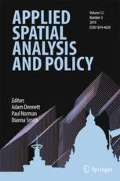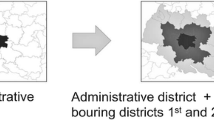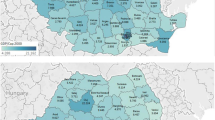Abstract
There has been a vast amount of discussion about the positive and negative regional effect on policy diffusion. During this debate, the role of neighborhood structure is ignored and the linear assumption is still prevailing in this field. By analyzing the spatial convergence of local vocational education development with data of 31 provinces from 1995 to 2008 in China, we explore the effects of neighborhood interactions on policy diffusion, paying specific attention to the dynamical role of neighborhood structures in policy diffusion. The empirical results clearly indicate that the development of local vocational education systems in China is spatially autocorrelated to the neighboring provinces. Local vocational education systems converge more slowly if a spatially lagged dependent variable is introduced, while they converge faster if a spatially error variable is introduced. The policy transition between neighbors considering their local spatial context is analyzed with Spatial Markov Chain and a fundamental nonlinear connection between neighborhood structure and policy transition is unveiled. Using spatial econometric models, we also find that the socio-spatial diffusion patterns with the social factors such as consumption, urban/rural distribution and occupation serve as barriers to and amplifiers of policy diffusion. These results not only resonate with conventional linear wisdom on policy diffusion but also offer a new nonlinear perspective on socio-spatial patterns of policy diffusion that are clearly embedded within the local neighborhood structures.
Similar content being viewed by others
Notes
Research on policy transfer has shown that in many instances a transfer took place in a region because of particular political circumstances (e.g., a government trying to implement something new, a personal relationship between politicians, a broader regional policy agenda tied to certain funding mechanisms). All those factors are classified as institutional factors. Particular individuals in power positions have often played a key role when it came to implementing new or different vocational education structures and supporting the expansion of vocational education. They are the individual level factors. There is no doubt that policy diffusion is determined by institutional factors, individual level factors and neighborhood interactions at least. Here at least the roles of neighborhood interaction on local vocational education development have been detected.
There is conditional convergence besides absolute convergence. However, here it’s enough to just test absolute convergence including σ-convergence and β-convergence because the exploration of the convergence in vocational education brings insight into the neighborhood interaction and policy diffusion.
It is emphasized that the regional effect is positive by some policy scholars such as Berry and Berry (1990), Mooney and Lee (1995) and Ghosh(2010). However, the negative effect is also detected (De Groot 2010; Easterly and Levine 1998; Ades and Chua 1997). Spatial Markov Chain analysis is used here like a high power microscope to look inside of the neighborhood structures, identify the various parts of the neighbors and their spatial interactions to predict the development trend. It’s the first time to use this tool to investigate policy diffusion and the results are amazing. According to the results, both the positive and negative regional effects are captured and neighborhood structure is the determining factor.
Within this regionally based policy diffusion framework, policy scholars have emphasized that there is a regional effect on policy diffusion. Some scholars insist that the regional effect is positive, whereas others contend that there is a negative regional effect. Those two contrasting views have the same premise that the regional effect on policy diffusion is liner. However, the socio-spatial system in vocational education reflects a complex phenomenon characterized by its nonlinearity and inherent complexity and it cannot be understood by studying parts in isolation and in linear perspective. Our empirical results show that the very essence of the system lies in the spatial interaction between neighbors and the overall behavior that emerges from the neighborhood interactions due to different neighborhood structures.
Spatial regression models(spatial lag model and spatial error model) include relationships between variables and their neighboring values, which allows us to examine the impact that one policy observation has on other proximate policy observations. When the value of a policy indicator observed in one location depends on the values observed at neighboring locations, there is a spatial dependence. And spatial data may show spatial dependence in the variables (spatial lag model) and error terms (spatial error model). So, as Rincke (2007) and Gu(2012c) did, we use both spatial lag model and spatial error model here to simulate and forecast different potential policy diffusion mechanisms. Both models can be used to investigate policy diffusion, however, in this paper spatial lag model is better than spatial error model due to those statistic tests such as AIC, Lagrange Multiplier (lag), Robust LM (lag), Lagrange Multiplier (error) and Robust LM (error) in Table 7.
The question of what is the optimal neighborhood size is largely dependent on the relative strength of neighbors and is particularly important when one seeks to examine the dynamic equilibrium of a spatial game. As Gu (2013)’s research shows that the choice of the optimal neighborhood size typically is influenced not solely by the quality of the various competing strategies, but by the effect of the frequency with which those various competing strategies are found in the population. As a result, the optimal neighborhood size is not invariable when the competition pattern changes.
The dual structure theory of policy diffusion is tested and elaborated by us in another research that will be published soon.
In spatial neighborhood studies, building notions of space into analytical procedures may yield more comprehensive information than heretofore has been gathered on the spatial distribution of individual person. The comparisons on individual level and provincial level share the same characteristic of spatial interaction and spatial neighbors play important roles when the comparisons happen.
References
Ades, A., & Chua, H. B. (1997). Thy neighbor’s curse: regional instability and economic growth. Journal of Economic Growth, 2(3), 279–304.
Anselin, L. (1988). Spatial econometrics: Methods and models. Dordreche, Netherlands: Kluwer Academic Publishers.
Anselin, L., Florax, R., & Rey, S. (2004). Advances in spatial econometrics: Methodology, tools and applications. Berlin: Springer-Verlag.
Baicker, K. (2005). The spillover effects of state spending. Journal of Public Economics, 89(2–3), 529–544.
Barabasch, A., Huang, S., & Lawson, R. (2009). Planned policy transfer: the impact of the German model on Chinese vocational education. Compare, 39(1), 5–20.
Barro, R., & Sala-i-Martin, X. (1992). Convergence. Journal of Political Economy, 100(2), 223–251.
Barro, R., & Sala-i-Martin, X. (1997). Technological diffusion, convergence, and growth. Journal of Economic Growth, 2(1), 1–26.
Bennell, P., & Segerstrom, J. (1998). Vocational education and training in developing countries: has the World Bank got it right? International Journal of Educational Development, 18(4), 271–287.
Benz, A., & Fürst, D. (2002). Policy learning in regional networks. European Urban and Regional Studies, 9(1), 21–35.
Berry, B. (1972). Hierarchical diffusion: The basis of development filtering and spread in a system of growth centers in Growth Centers. In N. Hansen (Ed.), Regional Economic Development (pp. 108–138). New York: Free Press.
Berry, F. S., & Berry, W. D. (1990). State lottery adoptions as policy innovations: an event history analysis. The American Political Science Review, 84(2), 395–415.
Berry, B. J. L., Elliott, E., & Harpham, E. J. (1996). The yield curve as an electoral bellwether. Technological Forecasting and Social Change, 51(3), 281–294.
Boehmke, F. J., & Witmer, R. (2004). Disentangling diffusion: the effects of social learning and economic competition on state policy innovation and expansion. Political Research Quarterly, 57(1), 39–51.
Brinks, D., & Coppedge, M. (2006). Diffusion is no illusion neighbor emulation in the third wave of democracy. Comparative Political Studies, 39(4), 463–489.
Brockmann, M., Clarke, L., & Winch, C. (2008). Knowledge, skills, competence: European divergences in vocational education and training (VET)—the English, German and Dutch cases. Oxford Review of Education, 34(5), 547–567.
Brueckner, J. K. (2003). Strategic interaction among governments: an overview of empirical studies. International Regional Science Review, 26(2), 175–188.
Buckley, J., & Westerland, C. (2004). Duration dependence, functional form, and corrected standard errors: improving EHA models of state policy diffusion. State Politics & Policy Quarterly, 4(1), 94–113.
Caillods, F. (1994). Converging trends amidst diversity in vocational training systems. International Labour Review, 133, 241.
Cassette, A., Di Porto, E., & Foremny, D. (2012). Strategic fiscal interaction across borders: evidence from French and German local governments along the Rhine Valley. Journal of Urban Economics, 72(1), 17–30.
De Groot, O. J. (2010). The spillover effects of conflict on economic growth in neighbouring countries in Africa. Defence and Peace Economics, 21(2), 149–164.
Deskins, J., & Hill, B. (2010). Have state tax interdependencies changed over time? Public Finance Review, 38(2), 244–270.
Easterly, W., & Levine, R. (1998). Troubles with the neighbours: Africa’s problem, Africa’s opportunity. Journal of African Economies, 7(1), 120–142.
Egger, P., & Pfaffermayr, M. (2006). Spatial convergence*. Papers in Regional Science, 85(2), 199–215.
Ertl, H. (2002). The concept of modularisation in vocational education and training: the debate in Germany and its implications. Oxford Review of Education, 28(1), 53–73.
Ertl, H. (2006). European Union policies in education and training: the Lisbon agenda as a turning point? Comparative Education, 42(1), 5–27.
Festinger, L. (1954). A theory of social comparison processes. Human Relations, 7, 117–140.
Fort, G., Moulines, E., & Priouret, P. (2011). Convergence of adaptive and interacting Markov chain Monte Carlo algorithms. The Annals of Statistics, 39(6), 3262–3289.
Getis, A., Mur, J., & Zoller, H. (2004). Spatial econometrics and spatial statistics. London: Palgrave Macmillan.
Ghosh, S. (2010). Strategic interaction among public school districts: evidence on spatial interdependence in school inputs. Economics of Education Review, 29(3), 440–450.
Gilardi, F. (2010). Who learns from what in policy diffusion processes? American Journal of Political Science, 54(3), 650–666.
Godwin, M. L., & Schroedel, J. R. (2000). Policy diffusion and strategies for promoting policy change: evidence from California local gun control ordinances. Policy Studies Journal, 28(4), 760–776.
Green, A. (1999). Education and globalization in Europe and East Asia: convergent and divergent trends. Journal of Education Policy, 14(1), 55–71.
Griffith, D. (1987). Spatial autocorrelation. In: Citeseer
Grossback, L. J., Nicholson-Crotty, S., & Peterson, D. A. M. (2004). Ideology and learning in policy diffusion. American Politics Research, 32(5), 521–545.
Gu, J. (2012a). Harmonious expansion of China’s higher education: a new growth pattern. Higher Education, 63(4), 513–528.
Gu, J. (2012b). Spatial dynamics and determinants of county-level education expenditure in China. Asia Pacific Education Review, 13(4), 617–634.
Gu, J. (2012c). Spatial recruiting competition in Chinese higher education system. Higher Education, 63(2), 165–185.
Gu, J. (2013). Price collusion or competition in US higher education. Studies in Higher Education(ahead-of-print), 1–25.
Gu, J. (2014). Spatial dynamics, vocational education and Chinese economic growth. Journal of Systems Science and Information, 2(5), 385–400.
Haider-Markel, D. P. (2001). Policy diffusion as a geographical expansion of the scope of political conflict: same-sex marriage bans in the 1990s. State Politics & Policy Quarterly, 1(1), 5–26.
Hall, P. A. (1993). Policy paradigms, social learning, and the state: the case of economic policymaking in Britain. Comparative Politics, 25(3), 275–296.
Ingle, W. K., Cohen‐Vogel, L., & Hughes, R. (2007). The public policy process among southeastern states: elaborating theories of regional adoption and hold‐out behavior. Policy Studies Journal, 35(4), 607–628.
Jordana, J., & Levi-Faur, D. (2011). The global diffusion of regulatory agencies channels of transfer and stages of diffusion. Comparative Political Studies, 44(10), 1343–1369.
Knill, C. (2005). Introduction: cross-national policy convergence: concepts, approaches and explanatory factors. Journal of European Public Policy, 12(5), 764–774.
Kraemer, K. L., Gurbaxani, V., & King, J. L. (1992). Economic development, government policy, and the diffusion of computing in Asia-Pacific countries. Public Administration Review, 52(2), 146–156.
Lamothe, S. (2005). State policy adoption and content: a study of drug testing in the workplace legislation. State & Local Government Review, 37(1), 25–39.
LeSage, J., & Pace, R. (2009). Introduction to spatial econometrics. Boca Raton, Florida: Chapman & Hall/CRC.
Lirgg, C. D., & Feltz, D. L. (1991). Teacher versus peer models revisited: effects on motor performance and self-efficacy. Research Quarterly for Exercise and Sports, 62, 217–224.
Lockwood, P., & Kunda, Z. (1997). Superstars and me: predicting the impact of role models on the self. Journal of Personality and Social Psychology, 73(1), 91–103.
Lu, M., & Chen, Z. (2006). Urbanization, urban-biased policies, and urban–rural inequality in China, 1987–2001. Chinese Economy, 39(3), 42–63.
Matisoff, D. C. (2008). The adoption of state climate change policies and renewable portfolio standards: regional diffusion or internal determinants? Review of Policy Research, 25(6), 527–546.
McClelland, D. C. (1966). Does education accelerate economic growth? Economic Development and Cultural Change, 14(3), 257–278.
Meseguer, C. (2005). Policy learning, policy diffusion, and the making of a new order. The Annals of the American Academy of Political and Social Science, 598(1), 67–82.
Meseguer, C., & Gilardi, F. (2009). What is new in the study of policy diffusion? Review of International Political Economy, 16(3), 527–543.
Mintrom, M., & Vergari, S. (1998). Policy networks and innovation diffusion: the case of state education reforms. Journal of Politics, 60(1), 126–148.
Mooney, C. Z. (2001). Modeling regional effects on state policy diffusion. Political Research Quarterly, 54(1), 103–124.
Mooney, C. Z., & Lee, M. H. (1995). Legislative morality in the American states: the case of pre-Roe abortion regulation reform. American Journal of Political Science, 39(3), 599–627.
Moran, P. A. P. (1950). Notes on continuous stochastic phenomena. Biometrika, 37, 17–33.
Moutsios, S. (2009). International organisations and transnational education policy. Compare: A Journal of Comparative and International Education, 39(4), 469–481.
Nilsson, A. (2007). Current national strategies in vocational education and training: convergence or divergence? European Journal of Vocational Training, 41(2), 150–162.
Pacheco, J. (2012). The social contagion model: exploring the role of public opinion on the diffusion of antismoking legislation across the American States. Journal of Politics, 74(1), 187–202.
Porte, C., Pochet, P., & Room, B. (2001). Social benchmarking, policy making and new governance in the EU. Journal of European Social Policy, 11(4), 291.
Poterba, J. M. (1997). Demographic structure and the political economy of public education. Journal of Policy Analysis and Management, 16(1), 48–66.
Rey, S. J. (2001). Spatial empirics for economic growth and convergence. Geographical Analysis, 33(3), 195–214.
Rey, S. J., & Montouri, B. D. (1999). US regional income convergence: a spatial econometric perspective. Regional Studies, 33(2), 143–156.
Rincke, J. (2007). Policy diffusion in space and time: the case of charter schools in California school districts. Regional Science and Urban Economics, 37(5), 526–541.
Rogers, E. M. (1995). Diffusion of innovations (4th ed.). New York: Free Press.
Ryan, P. (1991). International comparisons of vocational education and training for intermediate skills. London: The Falmer Press.
Schettini, D., Azzoni, C. R., & Paez, A. (2011). Neighborhood and efficiency in manufacturing in Brazilian regions a Spatial Markov Chain analysis. International Regional Science Review, 34(4), 397–418.
Scott, P., & Kelleher, M. (1996). Convergence and fragmentation? Vocational training within the EU. European Journal of Education, 31(4), 463–481.
Shipan, C. R., & Volden, C. (2008). The mechanisms of policy diffusion. American Journal of Political Science, 52(4), 840–857.
Shipan, C. R., & Volden, C. (2012). Policy diffusion: seven lessons for scholars and practitioners. Public Administration Review, 72(6), 788–796.
Simmons, B. A., Dobbin, F., & Garrett, G. (2006). Introduction: the international diffusion of liberalism. International Organization, 60(4), 781–810.
Strebel, F. (2011). Inter-governmental institutions as promoters of energy policy diffusion in a federal setting. Energy Policy, 39(1), 467–476.
Streeck, W. (1995). Neo-voluntarism: a new European social policy regime? European Law Journal, 1(1), 31–59.
Volden, C., Ting, M. M., & Carpenter, D. P. (2008). A formal model of learning and policy diffusion. American Political Science Review, 102(3), 319–332.
Walker, R. M. (2006). Innovation type and diffusion: an empirical analysis of local government. Public Administration, 84(2), 311–335.
Wollschlager, N., & Reuter-Kumpmann, H. (2004). From divergence to convergence: a history of vocational education and training in Europe. European Journal: Vocational Training, 32, 12.
Young, A. T., Higgins, M. J., & Levy, D. (2008). Sigma convergence versus beta convergence: evidence from US county‐level data. Journal of Money, Credit and Banking, 40(5), 1083–1093.
Author information
Authors and Affiliations
Corresponding author
Rights and permissions
About this article
Cite this article
Gu, J. Spatial Diffusion of Social Policy in China: Spatial Convergence and Neighborhood Interaction of Vocational Education. Appl. Spatial Analysis 9, 503–527 (2016). https://doi.org/10.1007/s12061-015-9161-3
Received:
Accepted:
Published:
Issue Date:
DOI: https://doi.org/10.1007/s12061-015-9161-3




